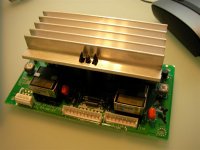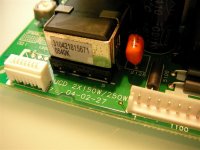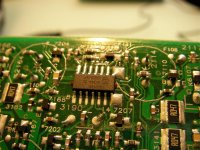Can only imagine that the impedance is 8 Ohms, which limits the Philips' output to some 65 W ..... Maybe the speakers have a low efficiency.
Why not try it out?
On my 8 Ohm T+A's I still experience enough power/sound and the sound is really cristal clear with a solid bass. Violins never sounded better, not to speak of a superb Bösendorffer recording.
Have fun.
Why not try it out?
On my 8 Ohm T+A's I still experience enough power/sound and the sound is really cristal clear with a solid bass. Violins never sounded better, not to speak of a superb Bösendorffer recording.
Have fun.
marconist said:Can only imagine that the impedance is 8 Ohms, which limits the Philips' output to some 65 W ..... Maybe the speakers have a low efficiency.
Why not try it out?
On my 8 Ohm T+A's I still experience enough power/sound and the sound is really cristal clear with a solid bass. Violins never sounded better, not to speak of a superb Bösendorffer recording.
Have fun.
So can you please tell us more about the sound quality of the DFR? Analytical/neutral/warm? Thin/body? Depth of stage? Timbre/tonality?
Thanks!
So can you please tell us more about the sound quality of the DFR? Analytical/neutral/warm? Thin/body? Depth of stage? Timbre/tonality?
Thanks! [/B][/QUOTE]
Well, yes, why not. I got the thing a couple of months now!
I got the thing a couple of months now!
My previous stereo amp: a NAD 1240 preamp + a DH4020 prof. stereo power amp (100W pc, 0,01 THD, FET, superstable) together with my rather old but "new-wooferized" T+A TMR100 transmission line speakers. (they do some 35 Hz easily!)
The DFR9000 replaced the amp and is now connected to the T+A's.
As I said before: its an 8 Ohm system so the Philips delivers only a max power of some 65 Watts pc. The room is 70m2, with the actual lsitening area some 40 m2.
In general the sound is neutral, although highs are silky and not harsh even when played on high levels. Bass is strict and very well controlled although I might say that the former DH4020 was a tiny little bit better in that ......
The sound certainly has body, I like to play a Bosendorffer piano recording on it as well a orchestral works and not to forget more modern stuff. The DFR9000 is not giving up in any range and reactions of the speaker system are the same as with the DH4020. So for me no degradation in listening pleasure.
Timbre, tonality and stage are to my opinion mostly set by the speakers you use and the TMR100's do very well there. Indeed there are (to many) amplifiers that influence the sound picture, but that is also the reason why I waited so long to replace the old set. I tried many sets (sometimes bought and sold, sometimes hired) but they all were too specific in sound. My max budget for a new preamp/amp was set at some €2000,-.
I consider the DFR9000 wonderful for the money!
Before I bought the DFR9000, I bought the servicemanual. (€25,- at
http://www.doknet.nl/eng/index.html
Its in PDF with all schematic's. The poweramp is indeed a "real" UcD with feedback behind the coil and the small print is build with components, so no IC's there. The (switching) PS is very complicated and that is probably the cause that the DFR9000 acts so good on pulse basses in modern music. You certainly do not miss big elco's.
The analog preamp is build around the TDA7468D which I think is a sota audio IC.
If you open the box it looks very well build and has a fan to cool ps and pwramp! You can only hear it when you put your ear on the receiver. (That probably will change after a couple of years ..... so than I change the fan. )
)
Disadvantages:
- Cabinet too small: no more connections possible unless you use switchboxes and so.
- Silly display which is difficult to read. You have to walk up to it to know you neutralised all tonecontrol.
- When applying stereosignals it tends to go to multichannel on most analog inputs. Of course you only have to switch only once for the source, but I would have liked it user-programmable.
- Limited programmability of the radio part.
- It has no mid preamp output to connect to your TV sound input.
Advantages:
- Nice small cabinet with funny display; everybody likes the looks of it .......
- Very good sound and a AM/FM and DAB radio too! (In Holland DAB still has a good bandwidth)
- Multichannel incl. decoders so you can play your films in HiFi.
- Many (menu) configuration possibilities.
- Faroundja picture improvements (yes, I almost forgot that it is a audio/video device
I use it mainly as a 4-channel device, looking for an acceptable mid-channel speaker. No subwoofer as I do not need/like these things for good music reproduction. It is nice however on some "earthquake" films.
As I still use a conventional Sony LCD projection TV, I do not comment on the Faroundja and HDMI things. Of course I also bought the set in mind that I want a HD screen one of these days! There are plenty of adjustments possible in the video range.
The Germans discussed a lot of that (in German!):
http://www.hifi-forum.de/viewthread-101-213-1.html
Oh yeah, its internal software is upgradable, but in fact only by some dealer. Look at the service-manual to see how that works.
WARNING: Listen to it on a good speakersystem and you probably buy it.
Thanks! [/B][/QUOTE]
Well, yes, why not.
My previous stereo amp: a NAD 1240 preamp + a DH4020 prof. stereo power amp (100W pc, 0,01 THD, FET, superstable) together with my rather old but "new-wooferized" T+A TMR100 transmission line speakers. (they do some 35 Hz easily!)
The DFR9000 replaced the amp and is now connected to the T+A's.
As I said before: its an 8 Ohm system so the Philips delivers only a max power of some 65 Watts pc. The room is 70m2, with the actual lsitening area some 40 m2.
In general the sound is neutral, although highs are silky and not harsh even when played on high levels. Bass is strict and very well controlled although I might say that the former DH4020 was a tiny little bit better in that ......
The sound certainly has body, I like to play a Bosendorffer piano recording on it as well a orchestral works and not to forget more modern stuff. The DFR9000 is not giving up in any range and reactions of the speaker system are the same as with the DH4020. So for me no degradation in listening pleasure.

Timbre, tonality and stage are to my opinion mostly set by the speakers you use and the TMR100's do very well there. Indeed there are (to many) amplifiers that influence the sound picture, but that is also the reason why I waited so long to replace the old set. I tried many sets (sometimes bought and sold, sometimes hired) but they all were too specific in sound. My max budget for a new preamp/amp was set at some €2000,-.
I consider the DFR9000 wonderful for the money!
Before I bought the DFR9000, I bought the servicemanual. (€25,- at
http://www.doknet.nl/eng/index.html
Its in PDF with all schematic's. The poweramp is indeed a "real" UcD with feedback behind the coil and the small print is build with components, so no IC's there. The (switching) PS is very complicated and that is probably the cause that the DFR9000 acts so good on pulse basses in modern music. You certainly do not miss big elco's.
The analog preamp is build around the TDA7468D which I think is a sota audio IC.
If you open the box it looks very well build and has a fan to cool ps and pwramp! You can only hear it when you put your ear on the receiver. (That probably will change after a couple of years ..... so than I change the fan.
 )
)Disadvantages:
- Cabinet too small: no more connections possible unless you use switchboxes and so.
- Silly display which is difficult to read. You have to walk up to it to know you neutralised all tonecontrol.
- When applying stereosignals it tends to go to multichannel on most analog inputs. Of course you only have to switch only once for the source, but I would have liked it user-programmable.
- Limited programmability of the radio part.
- It has no mid preamp output to connect to your TV sound input.
Advantages:
- Nice small cabinet with funny display; everybody likes the looks of it .......
- Very good sound and a AM/FM and DAB radio too! (In Holland DAB still has a good bandwidth)
- Multichannel incl. decoders so you can play your films in HiFi.
- Many (menu) configuration possibilities.
- Faroundja picture improvements (yes, I almost forgot that it is a audio/video device
I use it mainly as a 4-channel device, looking for an acceptable mid-channel speaker. No subwoofer as I do not need/like these things for good music reproduction. It is nice however on some "earthquake" films.
As I still use a conventional Sony LCD projection TV, I do not comment on the Faroundja and HDMI things. Of course I also bought the set in mind that I want a HD screen one of these days! There are plenty of adjustments possible in the video range.
The Germans discussed a lot of that (in German!):
http://www.hifi-forum.de/viewthread-101-213-1.html
Oh yeah, its internal software is upgradable, but in fact only by some dealer. Look at the service-manual to see how that works.
WARNING: Listen to it on a good speakersystem and you probably buy it.

Great review!
Maybe the service manual would be a good start for a DIY SMPS. We're not going to "get" one from hypex, and in light of the nuforces, iceamps and others of these days, a good matching SMPS for the different UcD's would be nice!
Anyway, nice to see a commercial UcD out there, and it seems to be a great performer also!
Maybe the service manual would be a good start for a DIY SMPS. We're not going to "get" one from hypex, and in light of the nuforces, iceamps and others of these days, a good matching SMPS for the different UcD's would be nice!
Anyway, nice to see a commercial UcD out there, and it seems to be a great performer also!
Another nice (with pictures) Italian review:
http://www.videohifi.com/17_9000eng.htm
Some small error in there: NO IC's in the UcD!
http://www.videohifi.com/17_9000eng.htm
Some small error in there: NO IC's in the UcD!
valvaholic said:Thanks for your concise impressions Marconist!
I know you don't use a sub, but will it control sub volume independently from its remote?
I'm also wondering if I can run a dedicated 240V/60Hz line to it from my fuse box (here in Canada!)?
Sub can only be controlled (like all other speakers) through the setup menu + or - 10 dB. Not directly from the remote!
I see no need for a transformer if you can use two phases in your country because the DFR9000 (as most Europe equipment) is not constructed in a phase sensitive way, so you should also not have grounding or interconnecting problems.
A separate pwr feed is handy, because the DFR9000 is quite demanding at full power! It wants energy FAST as there are no big elco's to act as an accumulator.
Because your country uses mostly open air powerlines I recommend some kind of power surge protection (like for a PC) with a very small internal resistance.
Edit: 60 Hz is originally not specced, but to my opinion no problem. There is only a small (50 Hz) transformer in the standby pwr supply, the "real" power is rectified first as usual with a SMPS.
Its more difficult for us Europeans to use American (60 Hz) transformers on 50Hz, because of the higher temperatures you then get.
The amp. looks very nice but when seeing a box full with digital stuff and a lot of wiring/in-outputs I wonder how "true"it will measure/sound? That was 1 of the reasons I wanted to get rid of my NAD C162/C272 combo........too many caps. and cheap wiring that will wear in not so much time and make the sound become less lively/dynamic.
Bgt said:The amp. looks very nice but when seeing a box full with digital stuff and a lot of wiring/in-outputs I wonder how "true"it will measure/sound? That was 1 of the reasons I wanted to get rid of my NAD C162/C272 combo........too many caps. and cheap wiring that will wear in not so much time and make the sound become less lively/dynamic.
Better look for yourself in the box and the schematics!
"By nature" there are very little capacitors in a UcD amp. And the wiring is not the problem; its the connectors! (And the dirty fingers of some "upgraders" )



- Home
- Amplifiers
- Class D
- UCD info: Philips DFR9000


